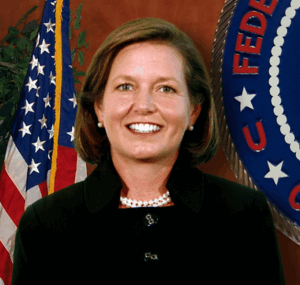Imagine finding out that a referee is being paid by one of the teams during a championship game. That’s essentially what’s happening in the relationship between the wireless industry and the Federal Communications Commission (FCC) – the very agency tasked with regulating it. This phenomenon, known as regulatory capture, is more than just a bureaucratic problem. It’s a public health issue, especially when it comes to exposure to electromagnetic fields (EMFs).
While wireless technology has rapidly evolved, the safety guidelines protecting the public from EMF radiation haven’t budged since the 1990s. Why? Because the same industry being regulated has a seat at the table, and often writes the rules.
In this blog, we’ll explore the FCC’s industry entanglements, how they’ve kept outdated EMF standards in place, what independent science says about health risks, and what steps you can take to protect yourself.
What Is Industry Capture – and How Has It Infiltrated the FCC?
Industry capture occurs when a regulatory agency, instead of acting in the public’s best interest, serves the commercial goals of the industry it is supposed to oversee. It’s the revolving door of personnel and profits: executives cycle between leadership roles in private corporations and top regulatory positions, bringing with them a bias that favors the companies they came from – or will return to. We see this in the relationship between Big Pharma and the FDA.
public’s best interest, serves the commercial goals of the industry it is supposed to oversee. It’s the revolving door of personnel and profits: executives cycle between leadership roles in private corporations and top regulatory positions, bringing with them a bias that favors the companies they came from – or will return to. We see this in the relationship between Big Pharma and the FDA.
At the FCC, this capture has become deeply entrenched. The commission, which should be enforcing safety and accountability in the telecommunications space, has instead enabled industry expansion with minimal oversight.
From Boardroom to Bureaucracy: When Industry Runs the Regulator
A few notable examples underscore this conflict of interest:
- Tom Wheeler, once the president of the CTIA (the main lobbying arm of the
 wireless industry), was appointed chairman of the FCC in 2013. While leading the FCC, he oversaw the rollout of 5G without implementing updated safety standards or calling for new health reviews.
wireless industry), was appointed chairman of the FCC in 2013. While leading the FCC, he oversaw the rollout of 5G without implementing updated safety standards or calling for new health reviews. - Meredith Attwell Baker, another former FCC commissioner, left her role to become the president of the CTIA – a job she took just months after approving a controversial industry merger.
This revolving door doesn’t just raise eyebrows. It directly affects policy outcomes. Decision-makers with industry ties are less likely to challenge the safety of the very technologies they once promoted.
Outdated EMF Exposure Guidelines: The Core of the Issue
The FCC’s current EMF exposure guidelines are based on thermal effects – essentially, how much radiation it takes to heat human tissue. These standards, adopted in 1996, assume that if EMFs don’t raise your body temperature, they must be safe.
But that assumption is deeply flawed. Research in the decades since has revealed that non-thermal effects – those that don’t cause noticeable heating – can still disrupt cellular function, DNA repair, hormone balance, and more.
Who sets these guidelines?
The FCC relies heavily on input from groups like IEEE and ICNIRP, both of which have been criticized for having close ties to telecom companies. Independent researchers, on the other hand, have been largely excluded from shaping policy.
5G Safety Standards and Wireless Health Risks
Background:
- As 5G networks rolled out, concerns grew about radiofrequency (RF) radiation health impacts.
- The FCC, in 2019, decided to maintain the old 1996 safety standards for RF exposure, despite the huge technological evolution since then.

Oversight Reaction:
- Public interest groups (like the Environmental Health Trust) sued the FCC, claiming it ignored scientific evidence showing potential harm.
- In Environmental Health Trust v. FCC (2021), the D.C. Circuit Court ruled against the FCC, stating the Commission failed to properly justify why the old standards were still sufficient and ignored evidence submitted to the record.
- The Court ordered the FCC to reconsider the evidence and better explain its reasoning.
Public and Congressional Pressure:
- Several members of Congress (especially from states like California) demanded further review and pushed for bills calling for updated RF exposure studies
Industry Studies vs. Independent Science
There’s a major divide between what industry-funded studies say about EMFs and what independent research shows:
- Industry-funded studies often conclude that EMFs are harmless. These studies are typically short-term, focus narrowly on thermal effects, or use outdated models of human exposure.
- Independent studies, meanwhile, consistently show biological disruption at exposure levels far below FCC limits. Effects include:

A 2006 analysis published in Environmental Health Perspectives found that industry-funded studies were two and a half times less likely to report biological effects compared to independently funded studies.
This funding bias mirrors what we’ve seen in Big Tobacco and Big Pharma: when profits are on the line, science can be bent.
Children and Chronic EMF Exposure: A Growing Concern
Children are especially vulnerable to EMF exposure for several reasons:
- Their skulls are thinner, allowing deeper EMF penetration.

- Their developing brains and nervous systems are more sensitive.
- They are being exposed earlier and for longer durations – often starting in infancy.
Studies have linked chronic EMF exposure in children to increased risks of:
- Attention issues
- Sleep disturbances
- Behavioral changes
- Headaches and fatigue
With schools increasingly adopting computer-based learning environments and kids spending hours on wireless devices, the long-term consequences remain largely unstudied – and alarmingly ignored by regulators.
What You Can Do: EMF Awareness and Protection
Here’s the empowering part: while the system may be slow to change, you don’t have to wait for the FCC to protect your health. Here are actionable steps you can take:
Limit Exposure at Home
- Turn off Wi-Fi at night.
- Use Ethernet cables instead of wireless connections.
- Keep devices in airplane mode when not in use.
Rethink Device Habits
- Avoid carrying your phone in your pocket, and women, definitely don’t carry it in your bra.
- Use speakerphone or wired headsets.
- Don’t sleep with your phone under your pillow.
Do Your Homework before Buying an EV (electric vehicle)
- Consider the consequences of driving or buying an EV.
- Research the health risks of long-term exposure to EVs.
- Do the benefits outweigh the risks?
Protect Children
- Minimize tablet and phone use.
- Use wired internet in schools whenever possible.
- Create tech-free zones at home.
Advocate and Educate
- Share independent EMF research with friends and family.
- Contact local officials about safer technology in schools and public spaces.
- Support organizations calling for updated safety standards.
Consider EMF Mitigation Tools

As part of a holistic approach, many people turn to EMF blocking devices, but these aren’t very practical for the modern human. One science-backed option is actually EMF modulation, and the leader in this field is undoubtedly Aires. Their products are designed to modulate and restructure EMF fields, reducing their biological impact without blocking your device’s functionality.
Unlike many “anti-radiation” gimmicks on the market, Aires devices are backed by peer-reviewed studies and third-party testing. They’re used by health professionals, biohackers, and parents alike who are looking for real-world tools to reduce EMF stress.
These devices work best in combination with lifestyle changes. They’re not a magic shield – but they are a practical and empowering addition to your toolkit.
Final Thoughts: Don’t Wait for the System to Wake Up
The exposure is moving faster than the science, and the science is moving faster than the policies. While the FCC remains entangled with industry and slow to respond to emerging risks, you don’t have to be passive. Don’t let 30-year-old data drive your decisions to protect your health.
By understanding the invisible influence of regulatory capture and taking your health into your own hands, you can make smarter, safer choices for yourself and your family. EMFs aren’t going anywhere, but you can do your best to stay informed and protected now and in the future.
Stay informed. Stay empowered. And remember: small changes can have a big impact when it comes to your long-term well-being.


 wireless industry), was appointed chairman of the FCC in 2013. While leading the FCC, he oversaw the rollout of 5G without implementing updated safety standards or calling for new health reviews.
wireless industry), was appointed chairman of the FCC in 2013. While leading the FCC, he oversaw the rollout of 5G without implementing updated safety standards or calling for new health reviews.






